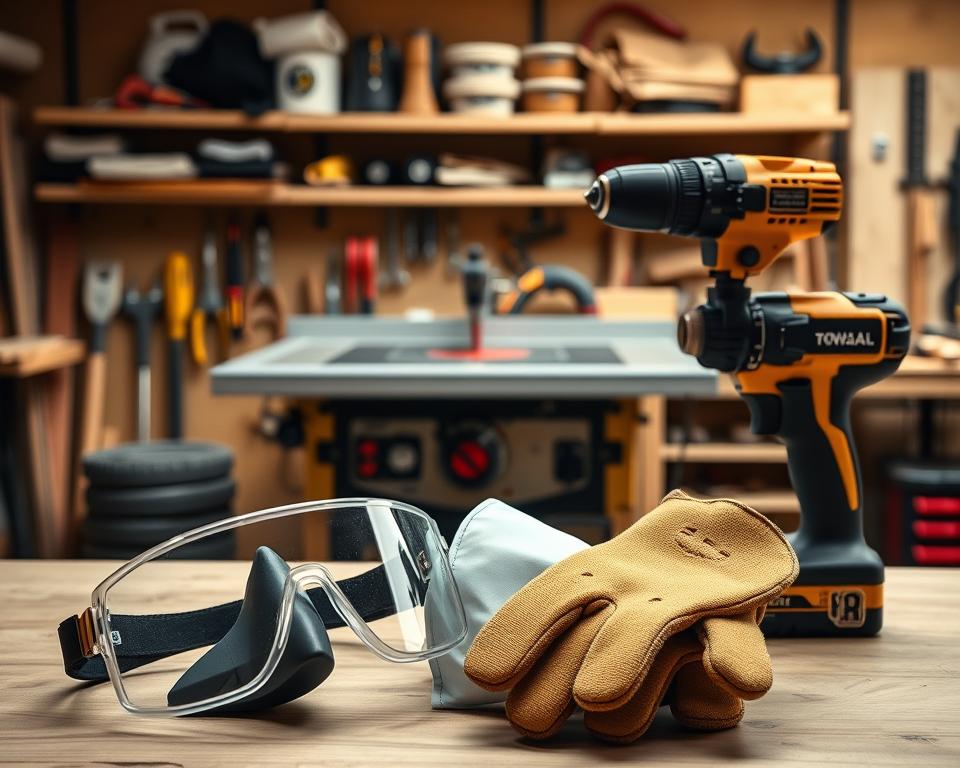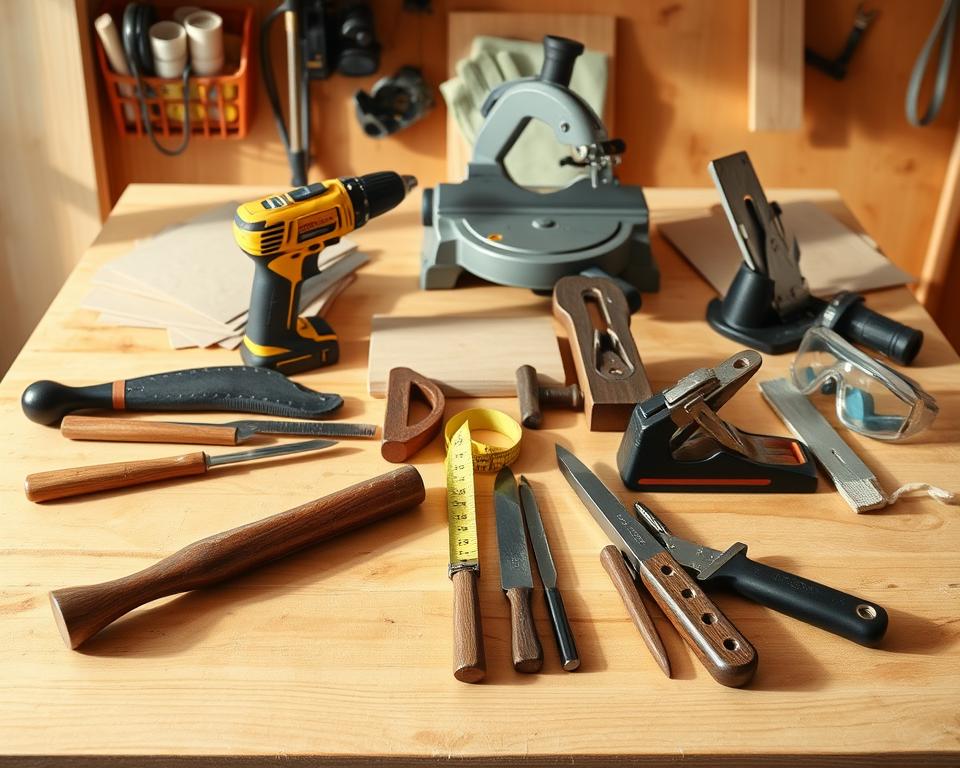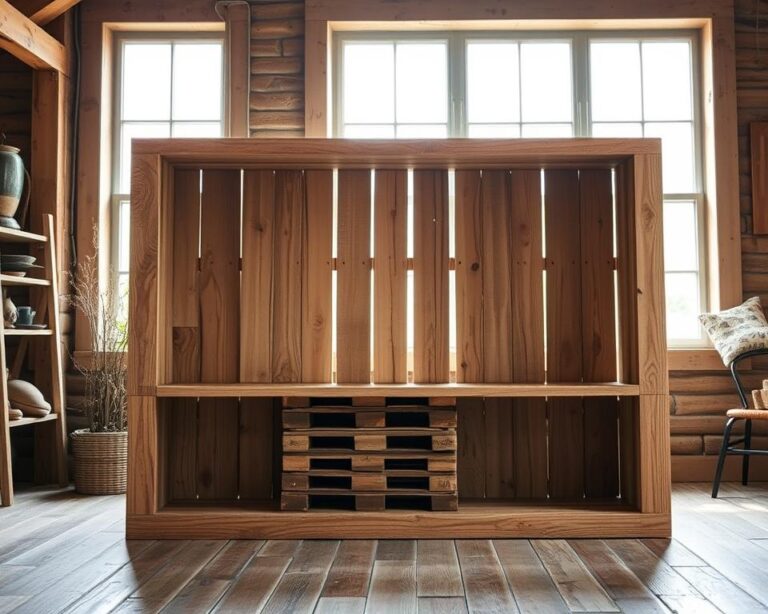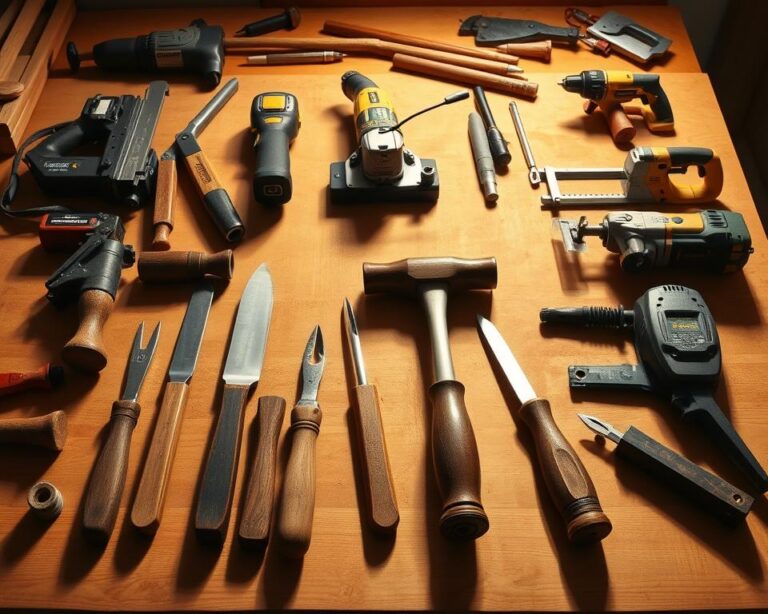Did you know nearly 40% of new woodworkers quit in the first year? This is often because they don’t have the right tools or know-how. Getting the right tools can really boost your skills and keep you excited about woodworking. We’ll look at the must-have tools for beginners that won’t break the bank.
Choosing tools that are both good quality and easy to use is key. These tools will help you learn the basics of woodworking. They are perfect for anyone starting out or looking to improve their skills.
Introduction to Wood Joinery Basics
Learning about wood joinery is key to being good at woodworking. It involves different ways to connect wood pieces, making them strong and lasting. Whether you’re working on simple projects or complex furniture, knowing these techniques will improve your skills and creativity.
Understanding Wood Joinery
Wood joinery basics include important methods like butt joints, dowel joints, and mortise and tenon joints. Each method is used for different projects and has its own benefits. For example, butt joints are easy and need few tools, while mortise and tenon joints are very strong. Knowing these techniques lets you choose the right joinery for your project.
Importance of Choosing the Right Tools
Having the right tools makes your joinery work better and more accurate. Good tools, like chisels and hand saws, help you make precise cuts and clean finishes. Tools like marking gauges also help you make consistent joints. For more tools and tips, check out essential wood joinery tools. The right tools will help you get better and make your woodworking projects last longer.
Essential Hand Tools for Woodworking
Starting out in woodworking? The right tools can make a big difference. Focus on quality and versatility to learn wood joinery basics well. Here are three key tools every beginner should have.
The Versatile Hand Saw
A hand saw is a must-have in woodworking. It lets you make precise cuts in different materials, perfect for joints and fittings. Choose a saw that feels right in your hand and has a sharp blade.
Stanley and Irwin are known for their reliable saws. Keeping your saw sharp will make it last longer and improve your work.
Benefits of a Good Chisel
Chisels are crucial for clean joints and details. A good set of chisels helps you do fine woodworking with precision. Narex and Two Cherries make chisels that pros and hobbyists love.
It’s important to keep your chisels sharp and stored well. This will help you get the best results in your projects.
The Magic of Clamps
Clamps are essential for holding pieces together during assembly. They’re needed for gluing joints or stabilizing materials while cutting. You can find many types of clamps, like bar clamps and C-clamps, from Bessey and Jorgensen.
Getting a good set of clamps is worth it. They improve the accuracy and quality of your work.
| Tool | Key Features | Recommended Brands |
|---|---|---|
| Hand Saw | Versatile for various cuts | Stanley, Irwin |
| Chisel | Precision for joinery work | Narex, Two Cherries |
| Clamp | Holds pieces securely | Bessey, Jorgensen |
Must-Have Power Tools
In woodworking, picking the right power tools is key. It’s important to know the differences between tools. This ensures you spend your money wisely on the right tools.
Whether you’re starting out or want to improve, choosing the right tools is crucial. Knowing which tools are best for beginners is essential.
Corded vs. Cordless Drill
Corded drills are great for heavy tasks because they have more power. They give steady torque and don’t need charging. This makes them perfect for long work sessions.
Cordless drills, however, are more portable and convenient. They let you move around without being tied to a power source. They’re also lighter and easier to use, making them ideal for beginners.
When to Invest in a Jigsaw
A jigsaw is perfect for making intricate cuts and curved shapes in wood. If you’re working on projects with detailed shapes, a jigsaw is a good investment. It’s portable and easy to use, helping you improve your skills.
The Advantages of a Router
Routers are vital for shaping edges, making grooves, and adding decorative touches to wood projects. They help you achieve professional-looking results. A good router can greatly improve your work’s quality.
For beginners, investing in a quality router can lead to impressive results. It shows off your skill and attention to detail.
Measuring and Marking Tools
Accurate measuring and marking tools are key to successful woodworking. Without them, even small mistakes can lead to big problems. Learning to use these tools well is crucial for anyone starting in woodworking.
Accurate Tape Measures
A good tape measure is essential in woodworking. Look for one that has both standard and metric measurements. The retractable blade should lock in place for accurate cuts. A quality tape measure saves time and prevents mistakes.
Importance of a Square
A square is vital for right angles in woodworking. It ensures your cuts and frames are perfectly aligned. Choose a durable square, like a combination square, for versatility. This improves your project’s quality.
Using a Marking Gauge
Marking tools, like a marking gauge, are crucial for precise measurements. They help mark lines parallel to your workpiece’s edge. Choose a gauge with an adjustable arm for flexibility. Knowing how to use these tools boosts your skills and project results.
Toolkits Under $100
Starting your woodworking journey? Finding the right toolsets is key. Toolsets for beginners under $100 are a great start. They offer a range of options to help you begin your projects.
Pre-Packaged Tool Sets
Pre-packaged tool sets are great for new woodworkers. They include everything you need for different tasks. For example, the Lamptop 47-piece set has hand tools and accessories for various woodworking tasks. These sets make choosing tools easy, making them ideal for beginners.
Building Your Own Starter Kit
Building your own starter kit lets you pick tools that fit your style and needs. This way, you ensure each tool is essential for your projects. It can make your woodworking experience better and sometimes save money.
Value vs. Quality
Finding the right toolsets means balancing cost and quality. While there are affordable options, check the tools’ durability and performance. A good starter kit can save you money by lasting longer and working better.
| Tool Set | Included Tools | Price | Features |
|---|---|---|---|
| Lamptop 47-Piece Set | Saws, chisels, clamps, measuring tools | $89.99 | Comprehensive starter kit, good quality |
| RYOBI 18V One+ Starter Kit | Drill, reciprocating saw | $99.99 | Power tools that share battery compatibility |
| DEWALT Hand Tool Set | Hammers, screwdrivers, pliers | $79.99 | Durable construction, trusted brand |
With careful thought, you can build a strong foundation for woodworking. Start your journey with the right tools.
Safety Equipment Essentials
Your health and safety should always be the top priority in woodworking. Getting the right safety gear can greatly lower injury risks. Here, we’ll talk about the key tools you need to stay safe while working with wood.
The Necessity of Safety Glasses
Safety glasses are a must for woodworkers. They protect your eyes from debris, dust, and shavings. Make sure they fit well and are made to withstand impacts.
Ear Protection for Power Tools
Power tools can be very loud and may harm your hearing over time. It’s crucial to wear ear protection when using tools like saws and drills. Choose earmuffs or earplugs that are comfy and block out a lot of noise.
Why You Need a Dust Mask
A dust mask is key for a safe workspace. Woodworking creates harmful dust particles. Pick a mask that catches small particles to protect your lungs. This simple tool can greatly improve your long-term health.

Upgrading Your Woodworking Workspace
Creating a great woodworking workspace can really boost your skills. Having a special area helps you focus better and work more smoothly. Planning and organizing your space can make woodworking more fun and productive.
Creating a Dedicated Area
A dedicated woodworking area is key for focus and less distraction. Pick a spot with lots of natural light and air. Make sure it’s away from busy areas so you can focus on your work.
Use shelves and storage to keep things tidy. This helps your workflow and makes woodworking more enjoyable.
Organizing Your Tools
Organizing your tools is crucial for a smooth workspace. Sort your tools by use, like hand tools and power tools. Use magnetic strips and pegboards to save space and keep tools handy.
Make a visual list of your tools. This helps you find what you need fast, saving time and reducing frustration.
Adding Workbenches and Surfaces
Workbenches are the heart of your woodworking space. A good bench boosts your productivity. Look for one with lots of space and useful features like built-in clamps.
Add extra surfaces for tasks like sawing or sanding. Customize your space for your projects. This ensures you work efficiently and comfortably.
Maintenance Tools for Longevity
Keeping your tools in good shape is key to making them last longer. Whether you use hand tools or power tools, knowing how to care for them is important. This helps them work better and keeps you safe. Here are some tips to keep your tools in top condition.
Caring for Your Hand Tools
Hand tools need regular care to stay sharp. Clean them after each use to get rid of dust and dirt. Keeping blades sharp helps you cut better and stay safe.
Store your tools in a dry spot to avoid rust. Use oil to protect them. Check for wear and damage often to catch problems early.
Keeping Power Tools in Shape
Power tools need special care. Check the battery health and replace it when needed for best performance. Clean the motor and vents to prevent overheating.
Look for frayed or damaged cords, as they can be dangerous. Regular maintenance keeps your power tools reliable for a long time.
The Role of Lubrication
Lubrication is crucial for both hand and power tools. It reduces friction, which helps prevent wear and tear. For hand tools, focus on joints and hinges. For power tools, make sure gears and bearings are well-lubricated.
Use the right lubricant as recommended by the manufacturer. This affects how well your tools work.
| Tool Type | Maintenance Task | Frequency |
|---|---|---|
| Hand Tools | Clean and sharpen | After each use |
| Hand Tools | Inspect for damage | Monthly |
| Power Tools | Check battery and cords | Before each use |
| Power Tools | Clean motor and vents | Monthly |
| All Tools | Lubricate moving parts | As needed |
Resources for Learning Joinery
To get better at woodworking, finding good resources for joinery is key. Many places offer helpful info, like online tutorials and books. Local classes and workshops give you hands-on practice, which boosts your skills a lot.
Online Tutorials and Videos
Online, you can find lots of woodworking knowledge. YouTube has many channels about joinery, showing you how to do it. This makes learning complex skills easier and faster.
Books on Woodworking Techniques
Books are a great way to learn woodworking deeply. Famous authors write about joinery, explaining tools and methods clearly. They let you learn at your own speed, making it easy to understand.
Local Workshops and Community Classes
Going to local workshops is a great way to learn. You get to work with experts and other woodworkers. This helps you learn more and meet people who share your interests.
| Resource Type | Examples | Benefits |
|---|---|---|
| Online Tutorials | YouTube channels, Online courses | Visual learning, flexibility, varied content |
| Books | “Complete Guide to Wood Joinery,” “The Woodworker’s Bible” | Dive into details, structured approach, reference material |
| Workshops | Local community colleges, woodworking clubs | Hands-on experience, networking, immediate feedback |

Joining Techniques for Beginners
Learning different joinery techniques is key for new woodworkers. Mastering basic woodworking joints can open up many project options. Let’s look at some essential methods that are easy to learn and very effective.
Simple Butt Joints
Butt joints are the simplest to make. They join two pieces of wood end to end. You can use glue or fasteners to hold them together. It’s a great way for beginners to start.
Make sure the edges are aligned for a clean look. Practicing with butt joints helps you get better at making precise cuts. This is a basic skill in woodworking.
The Power of Dowel Joints
Dowel joints offer better alignment and stability than butt joints. You drill holes in each piece and insert dowels. They’re great for bigger projects where you need more strength.
They also make your finished pieces look better. Dowel joints are a good choice for many projects.
Exploring Mortise and Tenon
Mortise and tenon joints are a classic choice for durability. They involve a tenon that fits into a mortise cut in another piece. These joints are strong and good for tables and cabinets.
While they’re a bit harder to learn, mastering them will greatly improve your skills. They’re a valuable addition to your woodworking toolkit.
| Joinery Technique | Ease of Use | Strength | Best Applications |
|---|---|---|---|
| Butt Joint | Easy | Low | Simple frames, small projects |
| Dowel Joint | Moderate | Moderate | Furniture, cabinets |
| Mortise and Tenon | Advanced | High | Tables, doors, strong frames |
Selecting the Right Type of Wood
Choosing the right wood is key for any woodworking project. Each wood type has its own special qualities that can make your project stand out. Knowing the difference between softwoods and hardwoods helps you pick the best wood for your needs.
Softwoods vs. Hardwoods
Softwoods come from coniferous trees and are easier to work with. They are lighter and cheaper, perfect for beginners. Examples include pine, cedar, and fir.
Hardwoods, from deciduous trees, are denser and more durable. They are harder to work with but offer beautiful finishes. Oak, maple, and cherry are popular choices.
Where to Buy Quality Lumber
It’s important to buy lumber from trusted suppliers. Local lumberyards and specialty stores usually have better quality than big chain stores. Look for suppliers who focus on sustainable and ethically sourced wood.
Understanding Wood Grains
Understanding wood grains is crucial for choosing the right wood. Grain patterns affect both look and durability. Tight grains mean strength and stability, great for furniture.
Wider grains might look better but are not as strong. Knowing about wood grains helps you pick the right wood for your project.
Conclusion: Starting Your Woodworking Journey
Starting your woodworking journey is exciting. Every great woodworker was once a beginner. You’ll get to express your creativity and learn new skills.
The tools and techniques you’ve learned are a great start. With patience and practice, you’ll enjoy making beautiful woodwork. It’s a rewarding hobby.
Encouragement for New Woodworkers
Starting woodworking can seem daunting. But, focus on small, achievable goals. Be open to learning from both successes and mistakes.
Connecting with other woodworkers can be very helpful. Their tips and motivation will keep you going. Remember, every expert was once a beginner. Stay persistent and enjoy the journey!
Your First Joinery Project Suggestions
Begin with simple projects like butt joints or a basic shelf. These projects will help you understand joinery techniques. They’ll also boost your confidence.
As you finish each project, you’ll feel a sense of accomplishment. These early wins will motivate you to take on more challenging projects.




